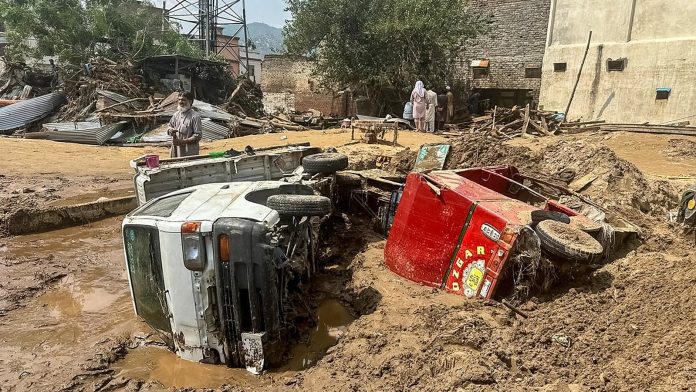Monsoon’s Fury Unleashed: Northwest Pakistan Grapples with Devastating Floods
In the rugged hills and serene valleys of Khyber Pakhtunkhwa, northwest Pakistan, nature has turned unforgiving. What began as a seasonal ritual—the arrival of monsoon rains—has transformed into a nightmare, claiming over 300 lives in just 48 hours. The intense and relentless downpour triggered a cascade of disasters: flash floods, violent cloud bursts, landslides, and haunting scenes of homes collapsing as the earth gave way beneath the weight of water and mud.
“It’s as if the heavens opened with an anger we have never witnessed,” whispered Asma Gul, a schoolteacher from Buner district, her eyes shadowed with exhaustion and grief. “The rivers swelled with fury, and the ground cracked and swallowed everything… neighbors, friends, even children.”
A Grim Toll: Lives Lost and Communities Shattered
By the dawn of August 19th, officials from the Provincial Disaster Management Authority confirmed 307 deaths across the parched, mountainous expanse of Khyber Pakhtunkhwa, with many more missing. Buner district, a once tranquil region located three and a half hours north of Islamabad, bore the brunt, losing 184 souls—nearly two-thirds of the reported fatalities. The dual forces of devastating cloud bursts and sudden flash floods ripped through villages, uprooting trees and washing away everything from homes to the local fruit orchards that sustained families for generations.
“There were moments when I felt the ground itself was alive, dragging my house into the river,” said Malik Shahid, a farmer who lost his entire livelihood. His trembling hands clutched at the remnants of a withered apple branch, symbolic of a life upended.
In the neighboring Shangla district, tragedy also unfolded brutally. The collapse of a building’s roof beneath the strain of relentless rain accounted for many of the 34 deaths there, an official reported. The echoes of grief ripple through these communities, not just because of lives lost but also due to the obliteration of homes, infrastructure, and fruit-laden orchards—symbols of stability and hope.
The Wider Regional Crisis: A Monsoon on the Rampage
This disaster is not isolated. Across the borders, parts of India and Nepal have been lashed by the same relentless weather system, illustrating the broader, unsettling trend of stronger, more erratic monsoon seasons in South Asia. Scientists link these intensifying events to global climate change, a reminder that no community, no matter how remote, is immune to the shifting patterns of a warming planet.
“Floods and landslides like these are becoming the new normal,” explained Dr. Neelam Khurshid, a climatologist based in Lahore. “We’re witnessing an acceleration of extreme weather events. This region’s vulnerability stems from a combination of geography, poverty, and insufficient infrastructure.”
Indeed, the monsoon season, traditionally a time when the land drinks deep and farmers rejoice, now features a dangerous double-edged sword of blessings and devastation.
Rescue, Relief, and the Struggle to Rebuild
In the midst of chaos, tireless rescue teams—both civilian and military—rushed into the flooded districts. Under the direction of provincial officials like Chief Secretary Shahab Ali Shah, relief operations sought to stem further loss.
“Loss is overwhelming, but so is the spirit to help,” Shah commented. “We have dispatched teams across the hardest-hit areas and set up medical camps and food stations for those displaced.”
Machines roared into action, clearing debris-choked roads to restore vital lifelines linking isolated communities to aid. Yet the human cost extended beyond the flooded streets. Just a day prior, tragedy struck the rescue effort itself, when a helicopter tragically crashed due to adverse weather conditions, killing five crew members—heroes in their own right who gave their lives amid the storm.
Deputy Prime Minister and Foreign Minister Ishaq Dar expressed somber condolences on social media: “Our hearts go out to the families who have lost loved ones, to those who are injured, and many whose homes and livelihoods have been swept away.” Prime Minister Shehbaz Sharif convened an emergency meeting, underscoring the government’s commitment to relief and recovery, but the scale of destruction poses a formidable challenge.
Cultural Echoes Amid Crisis: The Resilience of Khyber Pakhtunkhwa’s People
To understand the impact of this disaster, one must delve into the fabric of the region’s society. Khyber Pakhtunkhwa is a land of deep traditions, where hospitality is sacred, and community ties run strong. Despite the prevailing grief, neighbors are sharing what little remains with those displaced. Women, traditionally bound to their homes and hearths, have emerged as pillars of resilience, organizing communal kitchens and nursing the injured.
“In times like these, our Pashtunwali values—hospitality, honor, and resilience—shine bright,” said Amina Zafar, a local social worker coordinating relief efforts. “Even when the roads are washed away, the spirit never breaks.”
The Bigger Picture: Climate Change and Global Responsibility
One cannot help but reflect: what does this heartbreaking calamity tell us about our shared future? Around 5,000 kilometers away, a family watches news reports of Pakistan’s flood victims and wonders: could such devastation strike their homeland? How have our actions on the global stage—carbon emissions, deforestation, unsustainable development—increased the likelihood of these tragedies?
South Asia relies heavily on seasonal monsoons, which dictate the agricultural calendar and food security for millions. Yet the intensification of monsoons due to climate change threatens to upend these lifelines. The World Meteorological Organization warns that regions dependent on monsoon rains face increasing vulnerabilities, urging for global cooperation in mitigation, adaptation, and emergency preparedness.
This disaster is a clarion call, a vivid manifestation of climate change’s human toll. It asks: how do we safeguard the most vulnerable among us? How do we balance economic growth with environmental stewardship? And ultimately, how do we share responsibility beyond borders, acknowledging the interconnectedness of our planet?
Looking Forward: Hope on the Horizon
Despite the darkness, rays of hope glimmer. International aid groups are mobilizing to provide food, medicine, and shelter. Pakistan’s government has released emergency funds, though the road to recovery promises to be long and arduous. Local communities, scarred but unbroken, pledge to rebuild their lives and lands.
“The floodwaters will recede,” said Malik, the farmer, “but the memories and the lessons will remain. We must prepare, adapt, and unite.”
As readers across continents absorb this tragic yet hopeful story, it invites us all to ponder: how will we respond to the mounting climate urgencies unfolding worldwide? In the swirls of water and mud in Khyber Pakhtunkhwa, we see both devastation and the indomitable human spirit. Perhaps, therein lies the greatest story of all.










